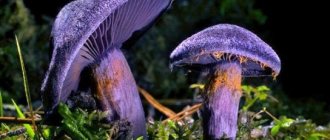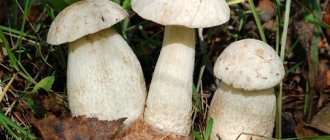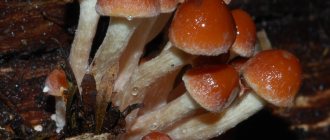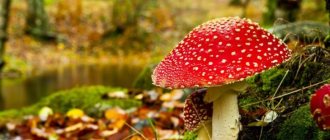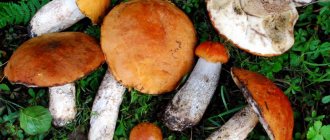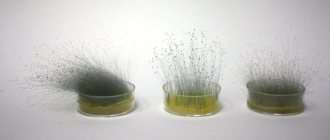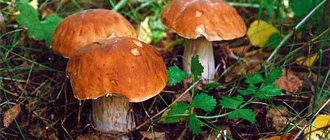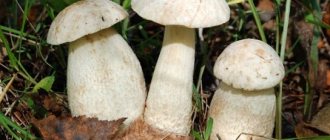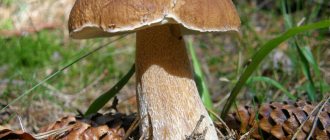We are accustomed to meeting standard and regular-shaped mushrooms on our way. As a rule, this is a light or dark cap, a distinguishable thick or thin leg. However, many mushroom pickers are truly impressed after they encounter the red trellis. This mushroom does not at all resemble those that we are used to seeing. The peculiar spherical shape and simple patterns do not indicate at all that this is a representative of the mushroom kingdom. Most likely, it looks like coral that for some reason ended up in Russian forests. Let’s find out what the main nuances of this mushroom are, and how dangerous or safe it is for humans.
Description and photo of the Red Reshotnik
Despite its uniqueness, this mushroom belongs to the Veselaceae family. Genus of lattice workers.
This family is found in abundance throughout the world, however, it inhabits mainly Australia and also the territory of South America. In Russia, the red trellis is the only representative of its family.
From Latin - Clathrus ruber.
Widely distributed in the western part of Russia, closer to the south.
This mushroom is incredibly rare and is also listed in the Red Book. Unfortunately, it was subject to active collection due to its non-standard appearance, which is why its population has decreased significantly. Let's talk about the description of this amazing forest dweller.
Let's start with the fact that if you encounter a young representative of this species, you will find a very interesting shape of the fruiting body in front of you. Most often it is ovoid or spherical. The height of the mushroom can reach a maximum of 10 cm, however, individuals with a diameter of 5 cm are still most often found.
If you look at the outer layer of the mushroom or even touch it, you will notice that it is very thin. However, over time, it may disappear completely, leaving behind a gelatinous middle layer. By the way, the middle layer is quite thick and powerful; it is a kind of frame for the mushroom.
The mushroom has a recipe. This is a special way of building a mushroom, which implies a vegetative body of a special shape. By the way, the shape is dome-shaped. Most often in Russian forests this mushroom is found in red color, however, closer to the European part, as well as in South America, this mushroom has a yellow and even white tint.
If you look at the inside of this mushroom, you will notice that it is covered with an olive-colored mucous membrane. The mushroom has a very unpleasant smell.
The description does not end there. The mushroom has a fairly well-spread mycelium, which stretches underground for several meters. However, these members of the family do not like to concentrate in one place in large groups. From one of their myceliums, one, maximum 3 mushrooms appear. The rest do not settle close, but at a considerable distance.
Spore-bearing layer
The spore-bearing surface is located on the inner side of the receptacle of a mature mushroom. It has a greenish-brown color.
Pulp
Density : soft and porous.
Color : reddish (matches the surface).
Organoleptic characteristics : ripe specimens emit a strong rotting odor to attract flies and other insects. Insects land on the mushroom, get dirty in mucus containing spores and carry them over considerable distances.
Spore powder
Spores: small, oval.
Spore powder: greenish-brown in bulk.
Fruiting body
The fruiting body of this mushroom is truly fragile. Therefore, if you see it in the forest, you should not even touch it. The fact is that the young representative of the species is quite elastic and can withstand touch. However, if the time for collection is approaching or has passed, touching this mushroom can simply crumble it into pieces. So it subsequently turns out to be dry and brittle at the end of the season.
The fruiting body has many different openings. Therefore, a large amount of moisture accumulates inside. Also, during the hot period, insects and even worms can settle there.
Description
Close-up of the spongy lattice "arms", showing the ridged and wrinkled outer surface and the glebe on the inner surface.
The front of the Volva opens, the fruiting body is ovoid to roughly spherical, up to 6 cm (2.4 in) in diameter, with a gelatinous interior up to 3 mm (0.1 in) thick. White to grayish in color, it is initially smooth, but before opening, a network of polygonal markings forms on the surface as the internal structures expand and stretch. peridium tight.[21] Fruiting body or vessel
, opens the egg as it expands (a process that can take only a few hours),[6] and leaves remnants of the peridium in a cup or Volva pattern around the base.[21]
The receptacle varies from red to bright pink to pale orange and is often lighter towards the base. Color depends on the temperature and humidity of the environment.[22] The receiver consists of a spongy network of "arms" intertwined to form cells of unequal size. At the top of the socket the arms are up to 1.5 cm (0.6 in) thick, but at the base they taper to a smaller width. A cross section of the arm reveals that it is spongy and consists of one wide inner tube and two fuzzy rows of tubes pointing outward. The outer surface of the vessel is ribbed or wrinkled.[21] The nest has between 80 and 120 holes.[23] The unusual shape of the vessel has inspired several creative comparisons: David Arora compared it to Whiffleball,[22] while the German Mycological Society—who named C. ruber
"Mushroom of the Year" for 2011—described it as "an alien from a sci-fi horror film." [24]
Considerable variation in vessel height has been reported, ranging from 8 to 20 cm (3.1 to 7.9 in).[6] The bases of the fruiting bodies are attached to the substrate by rhizomorphs (thickened cords of mycelium). Dark olive green to olive brown, sticky with an unpleasant odor. gleba covers the inner surface of the container, with the exception of its base. The smell—resembling rotting meat.[25][26]—attracts flies, other insects and, in one report, the scarab beetle ( Scarab Priest
)[27] which help disperse disputes.[22][28] The putrid smell—and people's reactions to it—is well documented. In 1862, Mordecai Cubit Cook wrote: “It is recorded of a botanist who collected one of them to dry it for his herbarium, that he was forced by the stench to rise in the night and throw the culprit out of the window.”[29] American mycologist David Arora called the smell "the most disgusting of all horns".[22] The receptacle collapses approximately 24 hours after the first eruption from the egg.[6]
The spores are elongated, smooth, measuring 4–6 by 1.5–2 µm.[21] Scanning electron microscopy showed that C. ruber
(in addition to several other Phallales species) has a gay scar, a small depression on the surface of the spore where it was previously connected to the basidium via the sterigma.[30] Basidia (spore cells) are hexosporous.[31]
C. columnatus
C. crispus
Similar species
Clathrus ruber
can be distinguished from the closely related tropical species
C. crispus
by the absence of the ruffled rims that surround each reticulated
C. crispus
fruiting body.[32]
The phylogenetically close species C. chrysomycelinus
has a yellow vessel with arms that are simpler in design, and its gleba is concentrated on specialized “glebifera” located at the intersections of the lattices.
It is known only from Venezuela to southern Brazil.[21] Clathrus columnatus
has a fruiting body with two to five long, vertical, spongy, orange or red columns joined together at the apex.[33]
Edibility and folklore
Various developmental stages of C. ruber
. Some of the "eggs" were cut in half to reveal their inner contents.
Despite the fact that the edibility of C. ruber
not officially documented,[34] its unpleasant odor would dissuade most people from eating it. In general, stink mushrooms are considered edible when they are still in the egg stage, and are even considered a delicacy in parts of Europe and Asia, where they are pickled raw and sold in markets as "devil's eggs".[22] An 1854 report issued a warning to those considering consuming the mature fruiting body. Dr. F. Pair Porcher, of Charleston, South Carolina, described a report of poisoning caused by mushrooms:
“A young man, after eating a little of it, six hours later suffered from painful tension in the lower abdomen and severe cramps. He lost the ability to speak and fell into a stupor that lasted forty-eight years. h. After taking an emetic, he threw out a fragment of a mushroom with two worms and mucus tinged with blood. Milk, butter and softening additives were then used with success."[35]
C. ruber
generally listed as inedible or poisonous in many British mushroom publications from 1974 to 2008.
British mycologist Donald Dring, in his 1980 monograph on the family Clathraceae, wrote that C. ruber
was not particularly valued in southern European folklore. He mentions a case of poisoning after ingestion reported by Barla in 1858 and notes that Ciro Pollini was reported to have found it on a human skull in a tomb in an abandoned church.[21] According to John Ramsbottom, the Gascons believed the fungus to be a cause of cancer;[36] they usually buried the specimens they found.[6] In other parts of France it was known to produce skin rashes or cause seizures.[36]
In the red book
This mushroom is incredibly beautiful and attracts attention not only with its shape, but also with its intense bright color. In the last century, it was distributed throughout Russia, especially in the Leningrad region, Yaroslavl, Moscow, Adygea, Krasnodar Territory, Yekaterinburg, Altai Territory, and on the Black Sea coast.
However, a mushroom that attracts so much attention could not go unnoticed. It was collected en masse not only for medicinal or other purposes, but also out of interest.
Also, the mushroom is adversely affected by the constantly deteriorating environment. Air pollution, water pollution, congestion on highways - all this reduced the growth of the fungus to a minimum, and they began to die out in huge groups. Today, the number of places where these mushrooms are concentrated in abundance is as small as possible. That is why it was decided to include this species in the Red Book of both the USSR and Russia.
The state of the population of this forest inhabitant is monitored. In addition, scientists are trying to breed mushrooms in reserves specially created for them.
Links[edit]
- " Clathrus ruber
P. Micheli ex Pers".
Index Fungorum
. CAB International. Retrieved July 3, 2010. CS1 maint: discouraged parameter (link) - Clathrus ruber
P. Micheli ex Pers.
1801″. MycoBank
. International Mycological Association. Retrieved July 3, 2010. CS1 maint: discouraged parameter (link) - ^ a b
Hosaka K., Bates S.T., Beaver R.E., Castellano M.A., Colgan V., Dominguez L.S., Nuhra E.R., Jeml J., Jachini A.J. , Kenny, S. R., Simpson, N. B., Spatafora, J. W., Trappe, J. M. (2006).
"Molecular phylogenetics of gomphoid-phalloid fungi with the establishment of a new subclass of Phallomycetidae
and two new orders".
Mycologia
.
98
(6):949–55. DOI: 10.3852/mycologia.98.6.949. PMID 17486971. - Holthius L. B. (1996). "Original watercolors given by Cornelius Sittardus to Conrad Gesner and published by Gesner in his (1558–1670) works on aquatic animals" (PDF). Zoologische Mededelingen
.
70
(11): 169–96. - Paul D. (1918). “Message from the President. On earlier research into mushrooms in Britain". Transactions of the British Mycological Society
.
6
(2): 91–103. DOI: 10.1016/s0007-1536(17)80018-8. Archived from the original on 2015-09-23. Retrieved February 7, 2011. - ^ B s d e g
Stijve T. (1997)
. "Close Encounters with Clathrus ruber
, the Lattice Stinkhorn" (PDF).
Australasian mycologist
.
16
(1): 11–15. Archived from the original (PDF) on 2014-10-05. CS1 maint: discouraged parameter (link) - Pegler D, Freedberg D (2006). Cassiano dal Pozzo Paper Museum. Series B: Natural History. Mushrooms
. London, UK: Harvey Miller Publishers. ISBN 1-905375-05-0. plates 96–100. - Micheli PA (1729). Nova plantarum genera iuxta tournefortii methodum disposita
(in Latin). Florence, Italy: Typis Bernardi Paperinii. paragraph 214. - Clathrus flavescens
Pers.
1801″. MycoBank
. International Mycological Association. Retrieved July 4, 2010. CS1 maint: discouraged parameter (link) - Jump up
↑ Fries EM (1823).
Systema Mycologicum
(in Latin).
2
. Lundin, Sweden: Ex Officina Berlingiana. item 288. - Clathrus nicaeensis
Barla".
MycoBank
. International Mycological Association. Retrieved July 4, 2010. CS1 maint: discouraged parameter (link) - Quadraccia L, Lunghini D (1990). "Contributo alla conoscenza dei macromiceti della tenuta Presidenziale di Castelporziano (Micoflora del Lazio II)" [Contribution to the study of macromycetes of the Presidential Estate of Castelporziano (Micoflora del Lazio II)]. Quaderni dell'Accademia Nazionale dei Lincei
(in Italian).
264
: 49–120. - Clathrus ruber
var.
Flavescens
(Pers.) Quadr.
& Lunghini". MycoBank
. International Mycological Association. Retrieved July 4, 2010. CS1 maint: discouraged parameter (link) - Clathrus
P. Micheli ex L. 1753″.
MycoBank
. International Mycological Association. Retrieved July 3, 2010. CS1 maint: discouraged parameter (link) - Jump up
↑ Rea C. (1922).
British Basidiomycetes: A Guide to the Great British Fungi
. Cambridge, UK: Cambridge University Press. paragraph 21. - Phillips R. Clathrus ruber
.
Rogers Mushrooms
. Rogers Plants LLC Archived from the original on 2011-07-16. Retrieved July 4, 2010. CS1 maint: discouraged parameter (link) - Jump up
↑ McKnight VB, McKnight KH (1987).
A Field Guide to Fungi: North America
. Boston, MA: Houghton Mifflin. item 345. ISBN 0-395-91090-0. - "Recommended English names for mushrooms in the UK" (PDF). British Mycological Society. Archived from the original (PDF) on July 16, 2011. CS1 maint: discouraged parameter (link)
- ^ a b
Ivantsevich B, Tatik B (2003).
"First record of Clathrus ruber
from Serbia".
Mycologia Balcanica
.
1
: 59–60. - Balzeau K, R Joly (2014). A la research of champignons - 2e. ed.: Un guide de terrain pour comprendre la nature - Champignons de nos forêts, sachez les reconnaître
(in French). Danod. item 166. ISBN. 978-2-10-071799-6. - ^ a b c d e f g h i j k
Dring, D. M. (1980).
"Contributions to the rational arrangement of Clathraceae". Kew Bulletin
.
35
(1):1–96. DOI: 10.2307/4117008. JSTOR 4117008. - ^ a b c d e
Arora, D. (1986).
Mushrooms Demystified: The Complete Guide to Fleshy Mushrooms
. Berkeley, CA: Ten Speed Press. paragraph 765. ISBN 0-89815-169-4. - ^ a b
Zhishu B., Zheng G., Taihui L. (1993).
Macrofungal Flora of Guangdong Province of China (China University Press)
. New York, New York: Columbia University Press. item 542. ISBN. 962-201-556-5. - "Pilz des Jahres 2011: Roter Gitterling ( Clathrus ruber
Pers.)" (In German). Deutsche Gesellschaft für Mykologie. Retrieved February 7, 2011. Diese Kreatur sieht eher aus wie ein Alien aus einem Sciencefictionhorrorfilm. CS1 maint: discouraged parameter (link) - Wood M, Stevens F. Clathrus ruber
.
California mushrooms
. MykoWeb. Retrieved February 7, 2011. CS1 maint: discouraged parameter (link) - Jordan M. (2004). Encyclopedia of Fungi of Great Britain and Europe
. London, UK: Francis Lincoln. item 366. ISBN. 0-7112-2378-5. - Roman J. (2008). " Scarabaeus sacer
Linnaeus, 1758 (Coleoptera: Scarabaeidae) visitando un hongo de la especie
Clathrus ruber
Micheli: Persoon (Clathraceae)" [
Clathrus ruber
(Clathraceae) visited by
Scarabaeus sacer
(Scarabaeidae)].
Boletin de la SEA (Sociedad Entomológica Aragonesa)
(in Spanish).
42
: 348. ISSN 1134-6094. - Stijve T. (1996). “Stinkhorns galore.” Coolia
(in Dutch).
39
(4): 229–36. - Cook MC (1862). A simple and easy report on British mushrooms; With descriptions of abundant and poisonous species and a tabular arrangement of orders and genera
. London, UK: Robert Hardwick. paragraph 93. - Burke WR, Flegler SL, Hess WM (1982). "Ultrastructural studies of Clathraceae and Phallaceae (Gasteromycetes) spores". Mycologia
.
74
(1): 166–68. DOI: 10.2307/3792646. JSTOR 3792646. - Laessoe T, Pegler DN, Spooner W (1995). British Puffballs, Earthstars and Stinkhorns: an account of British gasteroid fungi
. Kew, UK: Royal Botanic Gardens. p. 184. ISBN 0-947643-81-8. - Dennis R. W. G. (1954). "Some West Indian Gasteromycetes". Kew Bulletin
.
8
(3): 307–28. DOI: 10.2307/4115517. JSTOR 4115517. - Kuo M. (August 2006). Clathrus columnatus
.
MushroomExpert.com
. Retrieved February 7, 2011. CS1 maint: discouraged parameter (link) - ^ a b c
Kuo M. (August 2006).
Clathrus ruber
.
MushroomExpert.Com
. Retrieved February 7, 2011. CS1 maint: discouraged parameter (link) - Porcher F. P. (1854). "On the medicinal and toxicological properties of cryptogamic plants of the United States". Proceedings of the American Medical Association
.
7
:280. - ^ a b
Ramsbottom J. (1953).
Mushrooms and Toadstools: A Study of Fungal Activities
. London, UK: Collins. pp. 187–88. - Jump up
↑ Miller HR, Miller OK (1988).
Gasteromycetes: Morphological and Developmental Features with Keys to Orders, Families and Genera
. Eureka, CA: Mad River Press. paragraph 76. ISBN 0-916422-74-7. - Eckblad F. E. (1975). "Additions and corrections to the Gasteromycetes of the Canary Islands". Norwegian Journal of Botany
.
22
(4): 243–48. - Alli H, Işiloğlu M, Solak MH (2007). "Macrofungi of Aydin Province" (PDF). Mycotaxon
.
99
: 163–65. Archived from the original (PDF) on February 10, 2011. CS1 maint: discouraged parameter (link) - Sarkina IS, Prydiuk MP, Heluta VP (2003). "Macromycetes of Crimea listed in the Red Book of Ukraine." Ukrainian Botanical Journal
.
60
(4): 438–46. ISSN 0372-4123. - Dennis R. W. G. (1955). "The Status of Clathrus
in England".
Kew Bulletin
.
10
(1): 101–106. DOI: 10.2307/4113923. JSTOR 4113923. - Jump up
↑ Miller GB (1988).
" Clathrus
in Cornwall".
Mycologist
.
2
(1): 17. DOI: 10.1016/s0269-915x(88)80116-2. - Roberts P (1988). " Clathrus ruber
: notes on two collections from Devon".
Mycologist
.
2
(1): 14–16. DOI: 10.1016/S0269-915X(88)80115-0. - Hope, S. (1989). " Clatrus ruber
on the Isle of Wight".
Mycologist
.
3
(3): 111–12. DOI: 10.1016/S0269-915X(89)80036-9. - Muskett AE, Malone JP (1978). "Catalogue of Irish mushrooms Part 1. Gasteromycetes." Proceedings of the Royal Irish Academy
.
78
(1): 1–12. - Burke W. R. (1979). Clathrus ruber
in California, USA, and world distribution records".
Mycotaxon
.
8
(2): 463–68. - Cunningham G. H. (1931). "Gasteromycetes of Australasia. XI. Phallas, part II." Proceedings of the Linnean Society of New South Wales
.
56
(3): 182–200. - Dominguez de Toledo L. (1995). “Gasteromycetes (Eumycota) del centro y este de la Argentina. II. Orden Phallales" (PDF). Botanical Journal (Tokyo)
(in Japanese).
42
(496): 243–44. - Fiasson JL, Petersen RH (1973). "Carotenes in the mushroom Clathrus ruber
(Gasteromycetes)".
Mycologia
.
65
(1):201–203. DOI: 10.2307/3757801. JSTOR 3757801. PMID 4686215.
When and where it occurs
Where can you encounter this mushroom?
It is believed that he likes to settle in watery areas. Grows in soil. They are only found singly. They prefer to choose broad-leaved forests for their growth. Less common in mixed ones. Very rarely found in the Krasnodar region. Also, it was detected several times in the Moscow region.
Situations often occur when this fungus is introduced into other regions. For example, representatives of the Botanical Institute in St. Petersburg conducted research and found out that for some reason the mushroom was brought to Gorno-Altaisk.
The mushrooms gradually acclimatize and get used to the conditions that arise. People help them with this.
external reference
| Wikimedia Commons has media related to Clathrus ruber . |
| Wikispecies has information related to Clathrus ruber |
- " Clathrus ruber
: Champimaginatis" on YouTube (in French with English text) - Bay Area Mycological Society Description and Images
| Taxon identifiers |
|
How it spreads
Like most other mushrooms, the red trellis prefers to reproduce by spores. However, it does this in a completely different way from other mushrooms. Let's consider how this process occurs for the hero of the article.
The mushroom reaches its maturity around mid-September. At this point, the spores also reach maturity. At the moment when the spore is ready for independent life, significant changes begin to occur in the body of the fungus. This means that, in accordance with the primordial instincts laid down, the cells of the latticeworker begin to release special substances and enzymes into the air that emit a strong odor. This smell is very similar to that characteristic of decaying flesh. Not the most pleasant, but still, it signals running processes. Thanks to this smell, all kinds of insects begin to flock to the mushrooms, feeling the desire to profit.
As a rule, most often these are flies, ants and forest beetles. Insects settle on the edges of the mushroom and try to understand where the smell is coming from. At this point, the spores settle and stick to the body.
The insects, realizing that they will not be able to feast on them, quickly fly away, however, taking with them a large number of spores. During the flight, they scatter them over the forest, thereby giving the opportunity for new life to arise. That is why the red trellis is quite common in forests, however, it does not grow in groups, prefers not to stay close to its fellows, but is dispersed over a large area.
Where do red trellises grow?
The red trellis prefers to grow under broad-leaved trees, around which the soil is rich in humus. Also a favorable environment for its germination is a wet litter of fallen leaves and rotting remains of wood. In exceptional cases, this species can grow in mixed forests.
The red trellis belongs to the category of heat-loving mushrooms, so it is able to survive only in those regions where the temperature does not drop below -5 degrees, regardless of the time of year. Therefore, the red trellis can be found in the Krasnodar region, the Caucasus and Crimea, mainly in those places where there is little illumination during the daytime. If the temperature drops below a critical level, the mycelium of the fungus dies.
Important! A single case of detection of this species was recorded in the Moscow region.
Outside of Russia, the red trellis is found in European countries with favorable climatic conditions. Its distribution area is also North America, North Africa and the Mediterranean region.
There have also been cases of fungus germination in greenhouse conditions, when its spores were introduced along with the soil. This is how this species came to Siberia, to the city of Gorno-Altaisk. The red trellis mainly grows in single specimens, but under conditions of high humidity and air temperatures above +25 degrees, germination of group plantings is possible.
Fruiting continues from spring to autumn. In this case, the fungus germinates only in the presence of favorable conditions.
Important! This is the only representative of the Veselkov family that is found in Russia.
Features, time and habitats in nature
The latticeworker's favorite place is deciduous forests, humus-rich soil, damp litter of fallen leaves and rotting woody debris. Rarely, this mushroom appears in mixed forests and coniferous forests. Swampy areas, where there is a lot of moisture and organic matter, are a suitable place for our species. The latticewort loves warm climates and can survive where the air temperature is above -5 degrees Celsius, so it is found in Russia in the southern regions: Crimea, Caucasus, Krasnodar Territory, and has about ten locations.
In our country, based on climatic factors, subtropical species are found; local populations have not been identified. At temperatures below minus 5 degrees, the mycelium of the fungus loses its viability. One day, the latticeworker was discovered on the territory of the Moscow region. Favorable conditions for development are warm and humid greenhouses in case of spores being introduced into tubs.
Outside our country, the distribution area of the fungus is European countries, the Mediterranean region, Northern Africa, and North America.
Fruiting occurs from spring to autumn, depending on local climatic conditions. The mushroom does not grow regularly, but at intervals, one specimen at a time; groups are less common. The latticeworker has no false doubles; it is so unique that it is impossible to confuse it with some other species.
What red grilles look like
As can be seen in the photo, the red trellis mushroom has a spherical or ovoid body in the shape of a lattice, which is why it received its name. But it acquires this appearance as it matures.
At the initial stage of development, the fruiting body of the lattice has a dense red shape with small black inclusions, which is located in an ovoid shell of a light shade. Its height is 5-10 cm, and its width is about 5 cm.
As it grows, the outer shell breaks and under it you can see several independent red petals, which are attached to one base. As they develop, they bend toward the ground and become rounded, forming a mesh ball consisting of individual cells connected to each other. The bridges are covered with an indented jagged fringe of a dense structure, and its shade does not differ from the color of the fruiting body.
The height of an adult mushroom varies between 10-12 cm, and the width is about 8 cm. In the form of a formed lattice, it can be stored for 120 days.
Edibility of Clathrus ruber
Unfortunately, despite its beauty and visual appeal, this mushroom is truly poisonous. Therefore, it should not be considered as a food source. In addition, this mushroom is also not used as a medicinal mushroom. Although, in ancient times it was believed that the red attractive forest dweller necessarily had healing properties. Therefore, various decoctions were made based on it. When the mushroom became dry, it was collected and ground into flour. They were given to the patient diluted in water.
Unfortunately, patients did not recover from such treatment; their health condition only worsened. In addition, it is believed that this mushroom is toxic and can cause hallucinations. Records were found of one of the village doctors who treated a man who had contracted consumption in a similar way. The doctor wrote that the man began to hallucinate, he saw ghosts, shadows, and also non-existent creatures.
Considering all this, this mushroom cannot be considered as an assistant in human treatment. Also, scientists strongly recommend, despite the beauty of the latticeworker, to avoid it, since the poison is found even on its surface. Therefore, if you control this bright forest dweller, for example, take it in your hand, then put your finger in your mouth, you will certainly get harm, including poisoning. In addition, this mushroom is very dangerous for small children to play with, although it is incredibly attractive.
For children, even a small dose of this mushroom can be lethal, and can easily lead to food poisoning. However, no recorded cases of death were found; however, this does not at all exclude the danger of such a fungus.
If we talk about possible benefits, then in recent years, when the red trellis began to gradually spread throughout Russia, people started talking about it as a very beautiful decorative ornament. Therefore, it is very often used as an element of landscape design.
In many ways, its bright colors and extraordinary appearance make it possible to attract some degree of contrast to an ordinary piece of land. Therefore, it is used both in large compositions and on small lawns.
However, mushrooms grow in place for no more than one year, rarely appearing in the same place twice. Therefore, designers have a lot of trouble replanting them from place to place every year.
Biochemistry
Lycopene
beta
-carotene
Like other stinky mushrooms, C. ruber
The element manganese bioaccumulates. It has been suggested that this element plays a role in the enzymatic breakdown of gleba with the simultaneous formation of odorous compounds. Compounds such as dimethyl sulfide, aldehydes, and amines—which contribute to gleba's unpleasant odor—are produced by enzymatic decarboxylation from the keto acid and amino acid, but the enzymes will only work in the presence of manganese.[6] A chemical analysis of the elemental composition of the gelatinous outer layer, the embryonic receptacle and the gleba showed that the gelatinous layer is most rich in potassium, calcium, manganese and iron ions. The calcium ion stabilizes the polysaccharide gel, which protects the embryonic vessel from drying out during egg growth. Potassium is necessary for the gelatin layer to maintain its osmotic pressure and retain water; high concentrations of the element are necessary to support rapid vessel growth. The high concentration of elements suggests that the stratum gelatinous layer has a “placenta-like” function—serving as a reservoir from which the vessel can be drawn out during rapid expansion.[6]
The pigments responsible for the orange to red color of mature fruiting bodies have been identified as carotenes, predominantly lycopene and beta
-carotene is the same compound responsible for the red and orange colors of tomatoes and carrots, respectively.
Lycopene is also the main pigment of a closely related fungus. Clathrus Archeri
, while
beta
-carotene is the predominant pigment in the Phallaceae species
Mutinus caninus
,
M. ravenelii
, and
M. elegans
.[50]
How to distinguish red latticeworts
The unusual appearance of the red grille will not leave anyone indifferent. Therefore, it is impossible to confuse it with other mushrooms. In addition, there are a number of differences that significantly distinguish it from other species.
Characteristic features:
- ovoid light shell;
- red tint of the fruiting body;
- irregular cell shape;
- unpleasant putrid odor during ripening;
- absence of a leg;
- jagged fringe along the edge of the bridges.
Related species
Red lattice mushroom is an inedible mushroom. In the climatic conditions of Russia it has no edible counterparts. Inedible and conditionally edible species included in the Veselkov family include:
- java flowertail;
- Archer's flowertail;
- Mutinus canis;
- Mutinus Ravenelli.
Java flowertail
Javan flowertail is an inedible mushroom listed in the Red Book. In appearance, the fruiting body resembles a cigar or a spindle and consists of 3-8 parts (blades).
The color of young organisms is whitish, while that of older ones is orange-red. The body stands on a low hollow stalk. On the inner side of the lobes there is an olive-colored mucous gleba. The inner side and sides of the “blades” are wrinkled. The Javan flowertail species has a pungent odor, which attracts insects and carries spores for many kilometers.
This flowertail is most often found in Australia, North America, New Zealand and Africa. He loves warm, even hot climates. Prefers soil rich in humus on the outskirts of the forest; it is a saprophyte.
Archer's flowertail
The mushroom has an unpleasant odor.
Another inedible species is the Archer's flowertail (Argera). His homeland is Australia. In France it was first noticed in 1814. In the rest of Europe it appeared only in the 19th century. It received its name in honor of the mycologist W. Archer.
It has this description:
- pear-shaped fruiting body;
- the diameter of the fruiting body is 5-6 cm;
- the mycelial hyphae are long and located at the base;
- peridium whitish, with a gray tint;
- the receptacle develops after the outer membrane ruptures;
- no legs;
- the inner surface of the receptacle is spongy;
- the smell is pungent and unpleasant.
The receptacle, bursting, becomes like tentacles, and the shape of the entire mushroom immediately becomes star-shaped and reaches 15-16 cm in diameter. The wrinkled inner surface is covered with greenish spots - spore-bearing gleba. The blades have delicate, fragile flesh. The spores are medium sized (in terms of microscopic size), shaped like narrow cylinders, and olive or green in color. The young organism is sometimes confused with the common vesel.
The smell, unpleasant to the human sense of smell, attracts small insects, which help spread the organism, carrying its spores in different directions.
Archer's flowertail is characterized by orange-red lobes of the fruiting body, which in a mature specimen are separated at the top and spread out like a star; it can settle not only on rotting wood or humus soil, but also on the sands of deserts or semi-deserts. On the territory of the former USSR, it was found in the Aktobe region (Kazakhstan) on the sand among thickets of willows.
This saprophyte is found in deciduous or mixed forests from July to October. Rarely grows on sandy soils.
A sharp unpleasant odor warns that the mushroom is inedible and its flesh is tasteless.
Mutinus canis
One of the related species of the grille is Mutinus canis. It forms fruiting bodies from mid-summer to late October in North America and European countries.
Its description:
- the shape of the fruiting body is oval;
- diameter – up to 3.5 cm;
- height – up to 20 cm;
- the color of the spore-bearing gleba is light green;
- The surface of the gleba is cellular.
The surface of the recipe has a dull red tint, and the pulp smells unpleasant when broken. Fruiting begins in July and ends in the last days of October. The fungus settles in humus-rich soil and is a saprophyte.
Mutinus canis is a typical forest species, which is mainly found in deciduous forests on humus-rich soil. It can also be found in coniferous forests among thickets of bushes, sometimes around rotting tree trunks, but only in damp places. The young fruiting body is usually white, ovoid or oval in shape, reaching a diameter of 3-4 cm. The white peridium (shell) is broken by 2-3 lobes and is stored at the base of the fruiting body. The growing receptacle (sterile part) is colored in the upper part, pointed and passes into the head. The head is thin - no thicker than the base of the receptacle and is covered on top with an olive-colored mucous glebe.
Mutinus canis grows in families. It is necessary to collect (as in the case of Veselka) only specimens that are in an ovoid, unbroken shell. After it bursts, the gleba quickly dissolves into an unpleasant, but very attractive mass for insects. Insects attracted by its specific “aroma” carry the spores over long distances from the parent organism, which facilitates the spread of the fungus. After 3-4 days, not a trace remains of the whole mushroom.
Taxonomy, phylogeny and naming
Micheli's 1729 drawings of C. ruber
| Laternea triscapa | |
| Clathrus archeri | |
and selected Phallaceae species based on ribosomal DNA sequence[3]
Clathrus ruber
illustrated in 1560 by the Swiss naturalist Conrad Gesner in his
Nomenclature of Aquatilium Animantium
- Gesner mistook the fungus for a marine organism.[4]
It appeared in a woodcut in John Gerard's 1597 Great Herbal
, [5] shortly thereafter in Carolus Clusius' 1601
Fungus in Pannoniis Observatorum Brevis Historia
, [6] and was one of the species exhibited in the Cassiano Dal Pozzos
Museo Cartaceo
("museum paper"), consisting of thousands of illustrations of the natural world.[7]
The fungus was first described scientifically in 1729 by the Italian Pier Antonio Micheli in his Nova plantarum genera iuxta tournefortii methodum disposita
, giving it its current scientific name.[8]
This species was once referred to by American authors as Clathrus cancellatus
, as they used a system of nomenclature based on the former American Code of Botanical Nomenclature, which had Linnaeus's 1753 book
Species Plantarum
.
The International Code of Botanical Nomenclature now uses the same start date, but the names of Gasteromycetes used by Christian Hendrik Persoon in his Synopsis Methodica Fungorum
(1801) are authorized and automatically replace earlier names.
Since Persoon used the specific epithet ruber
, the correct species name is
Clathrus ruber
.
Now several historical names of the fungus are synonymous: Clathrus flavescens
, named by Persoon in 1801;[9]
Clathrus cancellatus
by Joseph Pitton de Tournefort and published by Elias Fries in 1823;[10]
Clathrus nicaeensis
, published by Jean-Baptiste Barlat in 1879. ;[11] and
Clathrus ruber
var.
flavescens
, published by Livio Cuadracchia and Dario Lunghini in 1990.[12][13]
Clathrus ruber
it is the type species of the genus
Clathrus
, and is part of the group
Clathrus
species known as the Laternoid series.
Common features that unite this group include vertical branches of the receptacle (fruiting body) that do not join together at the base, and a spongy structure of the receptacle.[14] According to a molecular analysis published in 2006, of the approximately 40 Phallales species used in the study, C. ruber
is most closely related to
Aseroe rubra
,
Clathrus archeri
,
Laternea triscapa
, and
Clathrus chrysomycelinus
.[3]
Common name Clathrus
comes from Ancient Greek κλειθρον or "lattice", and the specific epithet is Latin
ruber
, meaning "red".[15]
The fungus is commonly known as the "basket stinkhorn",[16] the "latticed stinkhorn",[17] or the "red cage".[18] It was known to the locals of the Adriatic hinterland in the former Yugoslavia as veštičije srce
or
vještičino srce
, meaning "witch's heart".[19]
This is still the case in some rural areas of France, where it is known as cœur de sorcière
.[20]
Impact on humans
Since the red trellis looks more like an unusual plant, few people will put it in their basket. Therefore, poisoning with it is rare. But sometimes it is used as a landscape composition, then it is in close proximity to people. Such a bright and exotic plant can be found by children, which most often happens. Signs of poisoning:
- Increased body temperature.
- Vomit.
- Loose stools with blood.
Medical assistance is not required, everything goes away on its own within 12 hours.
If you find a mushroom, you should not be afraid and trample on it. It is necessary to inform the environmental services, since this species is listed in the Red Book.
conclusions
If you are lucky enough to be walking through the forest and come across this mushroom on your way, you can admire it, capture it on your camera, or try to smell it. But please, under no circumstances tear it out of the ground, do not take it as a souvenir. The red lattice is not intended to be used as food or as a medicine. It’s not safe to hold it in your hands, and it’s not a good idea to leave it at home. It can easily poison your pets or children. Therefore, pass by such beauty, leave it alone, because this mushroom is already listed in the Red Book, which means it is on the verge of extinction. Don't leave your planet without this unique species, give it a chance to survive. And also look carefully at your step, because some red trellises are quite small and practically invisible in the grass. They are very easy to crush, thereby depriving us of such a wonderful population.
Interesting facts about the latticeworker
The type of lattice weed in question is a rather rare species of mushroom. For this reason, it is included in the Red Book of the Russian Federation.
Despite the fact that this specimen is inedible, it is impossible to get poisoned by it. Firstly, it is rare, and none of the mushroom pickers will purposefully look for it. Secondly, the fruit has such an unpleasant odor that you are unlikely to want to take it home and use it in cooking. In addition, not everyone knows that this interesting-looking plant belongs to the kingdom of Mushrooms.
If symptoms of general intoxication associated with accidental consumption of the lattice plant appear, you must immediately call an ambulance. Before her arrival, the child must be provided with plenty of fluids. It is not recommended to give food without a doctor's permission. With timely intervention, the symptoms of red lattice poisoning completely disappear after 10-12 hours, without causing harm to the child’s health.
On a note!
The lattice not only has no nutritional value, but also does not have any special beneficial properties. It is not used in folk medicine or pharmaceuticals.
The number of red myceliums and other varieties of trellis is rapidly decreasing. For this reason, such a miracle of nature must be carefully protected, since it also has benefits, even if it has no connection with the human body. You should not trample these fruits if you find them in the forest, just because they emit an unpleasant odor. Having seen such an instance, you must inform the appropriate authorities. In the future, they will be responsible for protecting the red lattice grass and similar species.
Recommendations
- " Clathrus ruber
P. Micheli ex Pers."
Index Fungorum
. CAB International. Retrieved 2010-07-03. - « Clathrus ruber
P. Micheli ex Pers.
1801 ". MycoBank
. International Mycological Association. Retrieved 2010-07-03. - ^ a b
Hosaka K., Bates S.T., Beaver R.E., Castellano M.A., Colgan V., Dominguez L.S., Nowhra E.R., Geml J., Jachini A.J. , Kenny, S. R., Simpson, N. B., Spatafora, J. W., Trappe, J. M. (2006).
“Molecular phylogenetics of gomphoid-phalloid fungi with the establishment of a new subclass. Phallomycetidae
and two new orders."
Mycology
.
98
(6):949–55. Doi:10.3852/mycologia.98.6.949. PMID 17486971. - Holtius L.B. (1996). "Original watercolors given by Cornelius Sittardus to Conrad Gesner and published by Gesner in his (1558–1670) works on aquatic animals" (PDF). Zoologische Mededelingen
.
70
(11): 169–96. - Paul D. (1918). “Message from the President. On earlier research into mushrooms in Great Britain." Transactions of the British Mycological Society
.
6
(2): 91–103. Doi:10.1016/s0007-1536 (17) 80018-8. Archived from the original on 2015-09-23. Retrieved 2011-02-07. - ^ a b c d f g gram
Stijve, T. (1997).
"Close Encounters with Clathrus ruber
," (PDF).
Australasian mycologist
.
16
(1): 11–15. Archived from the original (PDF) on 2014-10-05. - Pegler D., Friedberg D. (2006). Cassiano dal Pozzo Paper Museum.
Series B: Natural History. Mushrooms . London, UK: Harvey Miller Publishers. ISBN 1-905375-05-0. plates 96–100. - Micheli P.A. (1729). Nova plantarum genera iuxta tournefortii methodum disposita
(in Latin). Florence, Italy: Typis Bernardi Paperinii. paragraph 214. - « Clathrus flavescens
Pers.
1801 ". MycoBank
. International Mycological Association. Retrieved 2010-07-04. - Fries E.M. (1823). Systema Mycologicum
(in Latin).
2
. Lundin, Sweden: Ex Officina Berlingiana. item 288. - " Clathrus nicaeensis
Barla."
MycoBank
. International Mycological Association. Retrieved 2010-07-04. - Quadraccia L, Lunghini D (1990). "Contributo alla conoscenza dei macromiceti della tenuta Presidenziale di Castelporziano (Micoflora del Lazio II)" [Contribution to the study of macromycetes of the Presidential Estate of Castelporziano (Micoflora del Lazio II)]. Quaderni dell'Accademia Nazionale dei Lincei
(in Italian).
264
: 49–120. - « Clathrus ruber
var.
flavescens
(Person) Quadr.
And Lunghini." MycoBank
. International Mycological Association. Retrieved 2010-07-04. - " Clathrus
P. Micheli, ex L. 1753."
MycoBank
. International Mycological Association. Retrieved 2010-07-03. - Rea K. (1922). British Basidiomycetes: A Guide to the Large British Fungi
. Cambridge, UK: Cambridge University Press. paragraph 21. - Phillips R. " Clathrus ruber
."
Rogers Mushrooms
. Rogers Plants Ltd. Archived from the original on 2011-07-16. Retrieved 2010-07-04. - McKnight W.B., McKnight K.H. (1987). A Field Guide to Fungi: North America
. Boston, MA: Houghton Mifflin. item 345. ISBN 0-395-91090-0. - "Recommended English names for mushrooms in the UK" (PDF). British Mycological Society. Archived from the original (PDF) on 2011-07-16.
- ^ a b
Ivancevic B., Tatik B. (2003).
"First record of Clathrus ruber
from Serbia".
Mycologia Balcanica
.
1
: 59–60. - Balzo, C., Joly, P. (2014). A la research of champignons - 2e.
ed.: Un guide de terrain pour comprendre la nature - Champignons de nos forêts, sachez les reconnaître. (In French). Danod. paragraph 166. ISBN 978-2-10-071799-6. - ^ a b c d f g gram hour i j k
Dring D.M.
(1980). "Contributions to the rational arrangement of Clathraceae". Kew Bulletin
.
35
(1):1–96. Doi:10.2307/4117008. JSTOR 4117008. - ^ a b c d e
Arora, D. (1986).
Mushrooms Demystified: The Complete Guide to Fleshy Mushrooms
. Berkeley, CA: Ten Speed Press. item 765. ISBN 0-89815-169-4. - ^ a b
Zhishu B., Zheng G., Taihui L. (1993).
Macrofungal Flora of Guangdong Province of China (China University Press)
. New York, New York: Columbia University Press. item 542. ISBN 962-201-556-5. - "Pilz des Jahres 2011: Rother Gitterling ( Clathrus ruber
Chel.)" (in German). Deutsche Gesellschaft für Mykologie. Retrieved 2011-02-07. Diese Kreatur sieht eher aus wie ein Alien aus einem Sciencefictionhorrorfilm. - Wood M., Stevens F. " Clathrus ruber
."
California mushrooms
. MykoWeb. Retrieved 2011-02-07. - Jordan M. (2004). Encyclopedia of Fungi of Great Britain and Europe
. London, UK: Francis Lincoln. item 366. ISBN 0-7112-2378-5. - Roman J. (2008). " The Scarab Priest
Linnaeus, 1758 (Coleoptera: Scarabaeidae) visitando un hongo de la especie
Clathrus ruber
Micheli: Person (Clathraceae) "[
Clathrus ruber
(Clathraceae) visited
the Scarab Priest
(Scarabaeidae)].
Boletin de la SEA (Sociedad Entomológica Aragonesa)
(in Spanish).
42
: 348. ISSN 1134-6094. - Stijve, T. (1996). “Stinkhorns galore.” Coolia
(in Dutch).
39
(4): 229–36. - Cook MC (1862). A simple and easy report on British mushrooms;
With descriptions of abundant and poisonous species and a tabular arrangement of orders and genera . London, UK: Robert Hardwick. paragraph 93. - Bourke, W. R., Flegler, S. L., & Hess, W. M. (1982). "Ultrastructural studies of Clathraceae and Phallaceae (Gasteromycetes) spores". Mycology
.
74
(1): 166–68. Doi:10.2307/3792646. JSTOR 3792646. - Laesso, T., Pegler, D. N., & Spooner, B. (1995). British puffballs, earth stars and stinkhorns: a description of British gasteroid mushrooms
. Kew, UK: Royal Botanic Gardens. p. 184. ISBN 0-947643-81-8. - Dennis R. W. G. (1954). "Some West Indian Gasteromycetes". Kew Bulletin
.
8
(3): 307–28. Doi:10.2307/4115517. JSTOR 4115517. - Kuo M. (August 2006). " Clathrus columnatus
".
MushroomExpert.com
. Retrieved 2011-02-07. - ^ a b c
Kuo M. (August 2006).
" Clathrus ruber
".
MushroomExpert.Com
. Retrieved 2011-02-07. - Porcher F.P. (1854). "On the medicinal and toxicological properties of cryptogamic plants of the USA." Transactions of the American Medical Association
.
7
:280. - ^ a b
Ramsbottom J. (1953).
Mushrooms and Toadstools: A Study of Fungal Activities
. London, UK: Collins. pp. 187–88. - Miller H. R., Miller O. C. (1988). Gasteromycetes: Morphological and Developmental Features with Keys to Orders, Families and Genera
. Eureka, CA: Mad River Press. paragraph 76. ISBN 0-916422-74-7. - Ekblad F. E. (1975). "Additions and corrections to the Gasteromycetes of the Canary Islands". Norwegian Journal of Botany
.
22
(4): 243–48. - Alli H, Ishiloglu M, Solak MH (2007). "Macrofungi of Aydin Province" (PDF). Mycotaxon
.
99
: 163–65. Archived from the original (PDF) on February 10, 2011. - Sarkina I.S., Pridyuk M.P., Kheluta V.P. (2003). "Macromycetes of Crimea listed in the Red Book of Ukraine." Ukrainian Botanical Journal
(in Ukrainian).
60
(4): 438–46. ISSN 0372-4123. - Dennis R. W. G. (1955). "The Status of Clathrus
in England".
Kew Bulletin
.
10
(1): 101–106. Doi:10.2307/4113923. JSTOR 4113923. - Miller GB (1988). " Clathrus
in Cornwall".
Mycologist
.
2
(1): 17. doi:10.1016/s0269-915x(88)80116-2. - Roberts P (1988). " Clathrus ruber
: notes on two collections from Devon".
Mycologist
.
2
(1): 14–16. Doi:10.1016/S0269-915X(88)80115-0. - Hope K. (1989). " Clathrus ruber
on the Isle of Wight."
Mycologist
.
3
(3): 111–12. Doi:10.1016/S0269-915X(89)80036-9. - Muskett AE, Malone JP (1978). "Catalogue of Irish mushrooms Part 1. Gasteromycetes." Proceedings of the Royal Irish Academy
.
78
(1): 1–12. - Bourke W. R. (1979). " Clathrus ruber
in California, USA, and world distribution records".
Mycotaxon
.
8
(2): 463–68. - Cunningham G. H. (1931). "Gasteromycetes of Australasia. XI. Phallas, part II." Proceedings of the Linnean Society of New South Wales
.
56
(3): 182–200. - Dominguez de Toledo L. (1995). “Gasteromycetes (Eumycota) del centro y este de la Argentina. II. Orden Phallales". Darwiniana (San Isidro)
(in Spanish).
33
: 195–210. - Minicata K. (1928). " Clatrus cancellatus
TOURNEFORT本邦二産ス" [
Clatrus cancellatus
Tournefort in Japan for the first time] (PDF).
Botanical Journal (Tokyo)
(in Japanese).
42
(496): 243–44. - Fiasson J. L., Petersen R. H. (1973). "Carotenes in the fungus Clathrus ruber
(Gasteromycetes)."
Mycology
.
65
(1):201–203. Doi:10.2307/3757801. JSTOR 3757801. PMID 4686215.
